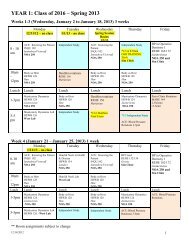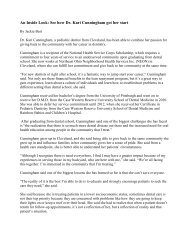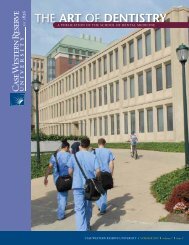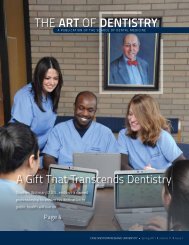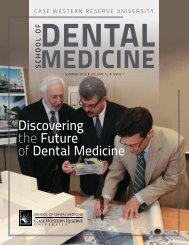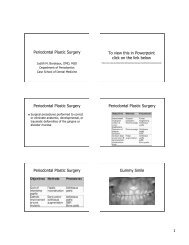THE ART OF DENTISTRY - School of Dental Medicine - Case ...
THE ART OF DENTISTRY - School of Dental Medicine - Case ...
THE ART OF DENTISTRY - School of Dental Medicine - Case ...
You also want an ePaper? Increase the reach of your titles
YUMPU automatically turns print PDFs into web optimized ePapers that Google loves.
ALUMNI PERSPECTIVE:<br />
EDWARD FERRERI ’40<br />
SERVICE WITH <strong>THE</strong> 4TH GENERAL HOSPITAL—<br />
FIRST IN <strong>THE</strong> FIRST WAR, FIRST IN WAR AGAIN…<br />
The 4th General Hospital—Lakeside Unit, which served during World War II—was initially<br />
commissioned by the U.S. War Department on October 1, 1933, acknowledging the<br />
sacrifice and pr<strong>of</strong>essionalism <strong>of</strong> doctors and nurses from Western Reserve University and<br />
the Cleveland area who had served during World War I at the U.S. Army Base Hospital<br />
No. 4—Lakeside Unit.<br />
The 4th General Hospital was activated<br />
at the dawn <strong>of</strong> World War II. Approximately<br />
200 members <strong>of</strong> the Cleveland medical,<br />
dental and nursing community left their<br />
homes at a moment’s notice to answer<br />
their country’s call. The medical/dental<br />
corps sole survivor, Edward Ferreri ’40,<br />
was deployed in early 1942 with his<br />
colleagues.<br />
FERRERI’S SAGA<br />
“The Cleveland doctors were the first in<br />
World War I, and they did such a good<br />
job that the government asked them to<br />
serve in World War II,” explains Dr. Ferreri.<br />
He became involved because “the army<br />
was shy two dentists with hospital training,”<br />
he says. “Hospital training ultimately<br />
saved me from the infantry. I was in the<br />
first military draft, which started in 1939.<br />
I received a deferment for a year because I<br />
was in an oral surgery residency program<br />
at what was then City Hospital in Cleveland.<br />
“I approached the dental reserve corps in<br />
1940, but they weren’t taking applications,”<br />
says Dr. Ferreri. “Then I tried to get into<br />
the Navy. I was deemed six pounds<br />
underweight. I went to a dietitian, who<br />
put me on a high-vitamin, high-caloric<br />
diet. Two weigh-ins later, I was still one<br />
pound underweight. It was looking like<br />
I was going to be a private in the army.”<br />
But, “in August 1941, Dean Wendell<br />
Wylie <strong>of</strong> the dental school told me <strong>of</strong><br />
an opening at the Medical College <strong>of</strong><br />
Virginia <strong>School</strong> <strong>of</strong> Dentistry in Richmond.<br />
I interviewed there and was hired<br />
immediately.”<br />
On January 17, 1942, Dr. Ferreri received<br />
a telegram from Joseph Wearn, M.D.,<br />
<strong>of</strong> the WRU medical school. “‘Your<br />
commission has come through as first<br />
lieutenant in the dental corps,’ he told<br />
me. ‘Wire your acceptance to the Surgeon<br />
General.’ Which I did, on a Wednesday.<br />
On Saturday <strong>of</strong> the same week, I received<br />
a call from the headquarters <strong>of</strong> the [Army]<br />
in Columbus, Ohio. They told me to report<br />
to the Brooklyn [N.Y.] port <strong>of</strong> embarkation<br />
by [the next day]. I got a [military] uniform<br />
that afternoon and was at the port by<br />
9:00 am. I was told, ‘Edward Ferreri,<br />
your task force unit number [is] 6414Z.’<br />
I didn’t know where I was going once I left<br />
New York.” He ended up going halfway<br />
around the world, to Melbourne, Australia.<br />
DOWN-UNDER CLINIC<br />
“The Aussies were happy to see us,” says<br />
Dr. Ferreri (who was honorably discharged<br />
as a captain). “Our first Marine division,<br />
after Guadalcanal, came to our hospital—<br />
the brand new Royal Melbourne Hospital—<br />
for medical and dental care. I spent a year<br />
in Melbourne. When we received orders<br />
that someone had to go to Oro Bay, at the<br />
362nd station hospital in New Guinea,<br />
three degrees <strong>of</strong>f the equator, I went.<br />
“The hospital facility was primitive,” says<br />
Dr. Ferreri. “The ward was a slab <strong>of</strong><br />
concrete, 200 feet by 30 feet. It was<br />
supported by posts. It had a tin ro<strong>of</strong>, no sides.<br />
The surgery suite was like a MASH unit.<br />
When I got there, we had no electricity to<br />
run the dental drill. I had to have a man<br />
operate a foot treadle while I worked. It<br />
wasn’t too long before we got electricity.”<br />
After about a year in New Guinea, Dr.<br />
Ferreri was sent back to the 4th General<br />
Hospital, which was now in New Guinea,<br />
as a patient (he had a skin infection). “To<br />
the relatives <strong>of</strong> the members <strong>of</strong> the 4th<br />
General Hospital I would say that I felt<br />
very fortunate to serve with so many<br />
experts in the fields <strong>of</strong> medicine, dentistry<br />
and nursing,” he says.<br />
Dr. Ferreri resides in East Cleveland,<br />
Ohio, at the A. M. McGregor Home, an<br />
independent and assisted-living facility on<br />
32 wooded acres where, he says, “I have<br />
no neighbors except wild deer and turkeys.”<br />
He lives with Jeanne, his wife <strong>of</strong> 58 years.<br />
The couple has seven daughters and one son.<br />
5



